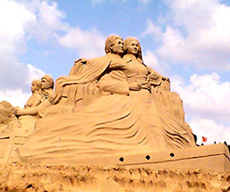
The theme "Legends of All Eras" unites the group of 26 sand
sculptures near the Wish Tower at the Dameisha beach in eastern
Shenzhen, stars of the Dameisha International Sand Sculpture
Festival, which opened September 27. The sculptures will weather
the elements until Christmas Eve, when their creators will destroy
them in a ceremony.
"Though we spray on a degradable glue to help preserve the
sculptures, they will gradually change, reminding us that beauty is
transient," said Yang Guang'an, manager of the festival project.
"So we will destroy them when they are still in shape." He made the
point that since the art form uses natural materials, sand
sculpting is environmentally friendly.
The sand sculpture festival is a major event of the Sixth East
Coast Tourism Festival organized by the Yantian District Tourism
Bureau, running through December 24.
The sculptors, four expats and 16 Chinese, worked from 8 AM to 6
PM each day, with each sculpture taking one sculptor and his
assistants six to 10 days to complete.
"It's the sixth sand sculpture festival at Dameisha since 2001,"
said Jiang Tao, chief of the Yantian tourism bureau, "and it's the
biggest event we've had so far."
Sand sculptures are made using only sand and water. Ephemeral in
nature, sand art is welcomed on beaches all over the world.
26 legends from East and West
Zhang Yongkang, younger of the "sand sculptor brothers" from
Zhoushan, east China's Zhejiang Province, spent three weeks designing
their "Legends of All Eras." Arranged in the shape of an eagle
spreading its wings, the 26 sculptures represent the 26 years of
Shenzhen's history as a special economic zone, set against the
background of human history.
The main sculpture, a seven-meter-tall re-creation of Diwang
Mansion, World Trade Building and other city landmarks, celebrates
the Shenzhen speed in economic growth. A nearby sculpture depicts
the Dameisha beach.
All sculptures on the left of the main sculpture are inspired by
Chinese legends and history - Pangu splitting the sky and earth
with a swing of his giant ax, Nuwa creating the first human,
Emperor Qinshihuang (246-221 BC), Ming Dynasty physician Li Shizhen
(1518-1593), and Chang'e, goddess of the moon.
Sculptures on the right depict ancient myths and cultures from
abroad - Eve picking fruit from the tree of knowledge, the sphinx
in front of a pyramid, a Greek marathon runner.
"I had hoped to add a sculpture of the monkey king or silly old
man moving mountains," Zhang Yongkang said, "but the ideas were
sacrificed to Dameisha scenes since the major theme is to mark the
city's growth."
Noteworthy is Zhang's sculpture "Nezha Overwhelms the Dragon
King." The original took third place in the 12th Scheveningen
International Sand Sculpture Festival in The Hague in 2002, with a
prize of 3,500 euros (US$4,450).
Playing with sand
"Growing up in a family of woodcarvers, my brother and I first
tried the art in 1999, when an international sand sculpting event
came to our hometown Zhoushan," Zhang Yongkang said.
Thanks to their experience in woodcarving and their interest in
sand art, the brothers won prizes at national and international
events. In 2001, elder brother Zhang Weikang came in fourth in the
World Sand Sculpture Championships at a seaside resort in
France.
"We found ourselves addicted to sand sculpting soon after the
first event, since it combines building, painting, sculpting and
outdoor sports," the elder Zhang said.
"It is a natural human instinct to play with sand, and it is the
best way to learn three dimensional sculpting with a free and easy
medium that everyone can access. With good sand and a few
techniques, almost anything is possible. The only restriction is
gravity."
Spadone Pasquale, a graduate of the Academy of Belle Art in
Naples, Italy, said he was happy to be part of the sculptors' team
at Dameisha. "Sand sculpting is all about having fun with friends,"
he said. "You can make as many mistakes as you want and change
them. Spending time shaping and carving the sand, you will see that
slowly the sculpture appears, and for a moment seems to come
alive."
Jason Kelly from Australia said he had organized many events in
Australia, Japan and Britain, mostly combining music, dance and
visual arts. "I've been playing with sand since I was 2 years old.
The beaches are out there and all you need is some imagination," he
said.
What Kelly did not mention is the hard work: using layers of
wooden frames to make the sand compact, watering the sand evenly
and pounding it into a solid sand block. Then the artists can carve
out the rough sculpture downward from the top into the desired
shape before removing the frame to reduce the weight.
(Shenzhen Daily October 11, 2006)

